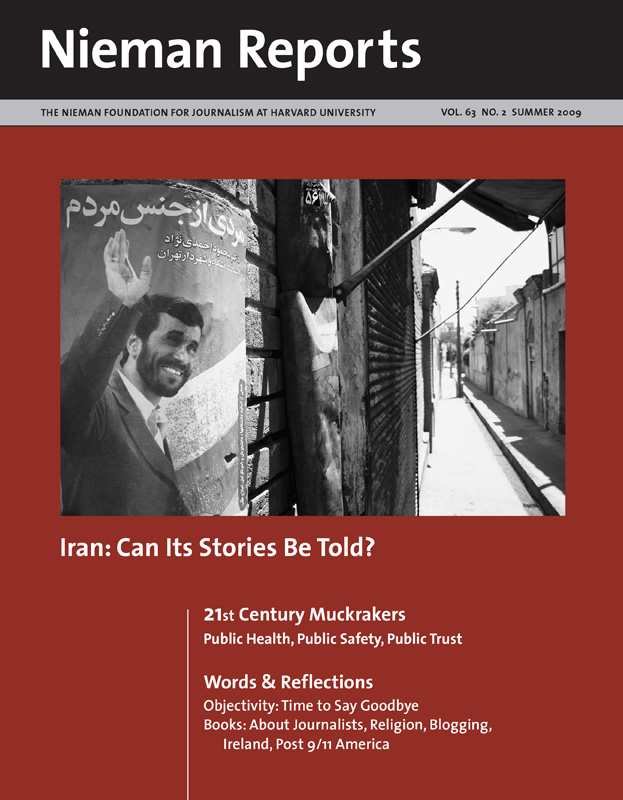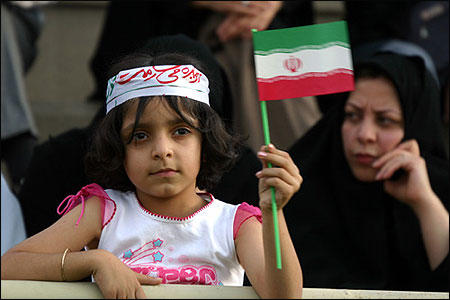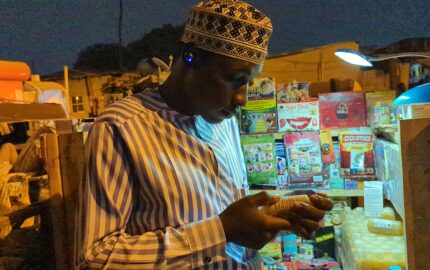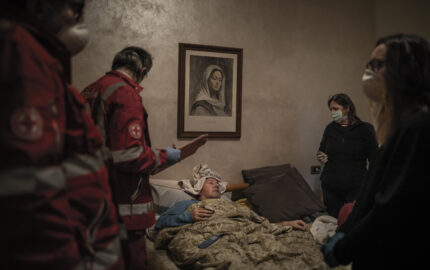

A young girl wore a headband and waved an Iranian flag in support of then reformist presidential candidate Mostafa Moein at a pre-election rally. May 2005. Photo by Iason Athanasiadis.
Before I left for Tehran in June 2005, Alireza Haghighi, a former Iranian official in exile in Canada, told me he was sure a conservative hard liner would win that month’s presidential election. Haghighi was almost entirely alone in that opinion. The outgoing president, Mohammad Khatami, was a mild-mannered reformist. Former President Ali Akbar Hashemi Rafsanjani, a pragmatic insider running on a reformist platform, was far and away the favorite in the American press, which confidently offered up interviews with Rafsanjani about his future administration. What made Haghighi think that Iran was moving in a more conservative direction?
“Go to a mosque in south Tehran,” he implored me. “Talk to young people there. You’ll see.”
American reporters are typically granted only short visas to work in Iran, with limited access to the country outside the capital. There is a lot we miss for lack of contact with rural Iranians, and even in Tehran, a sprawling city of 14 million, there is always the danger of sequestering oneself in too familiar a world. Haghighi, who grew up in a poor neighborhood in the south of Shiraz, complained that American reporters gravitated toward the glitz of the capital city’s northern heights, where they found Iranians who resembled themselves and expressed the political views they wanted to hear.
Seeking New Conversations
To the city’s south, the urban working class, hard hit by the country’s economic troubles, shares crowded quarters with recent migrants from the villages. This population is culturally conservative and religiously devout. In every way, the young people here have less freedom and privacy than their peers in the city’s north: They share cramped apartments with their parents, they don’t have cars, and their dress code and sexual behavior are heavily policed, both by their families and by the state.
As a woman, I could not mix easily at a mosque in this part of town, but my translator had another idea. We would go to the Bahman Cultural Center, a complex in south Tehran that provided a library, swimming pool, art museum, park and other amenities to poor urban youth. Under the shah, the neighborhood had been a squalid and dangerous wasteland of brothels and shanties. The Islamic Republic had made the renewal of this area one of its signal accomplishments, building the cultural center where a vast slaughterhouse once stood. Not only were there parks and museums here now, but there were also police, so that women could walk safely at night.
My translator had a cousin who worked at the cultural center and welcomed us onto the premises. Nonetheless, we were told to report to the center’s director, a woman in a blue flowered chador. She did not object when I told her I was there to interview young people, but she did press a tour guide on us. That young woman led us across the grounds, delivering rote descriptions of the facilities, which were well tended, linked by manicured lawns and paved walkways. On the outer walls of buildings, there were murals of militiamen with red headbands, and of martyrs from the war with Iraq, set against the ghosted image of Ayatollah Ruhollah Khomeini. There was also a mural of Charlie Chaplin, looking strangely sinister as he held a statue of himself in an improbably rotated, raised palm. Someone had affixed one of Rafsanjani’s campaign bumper stickers to the mural, across the base of the statue.
As we left the library, I saw a lawn where young women sat studying on the grass. I told the guide that I wanted to talk to them. She left us there. At the edge of the lawn, two Revolutionary Guards stood watch. One was a man in olive fatigues, the other an angular-faced woman in a black chador. With my translator, I approached them and informed them that I would be interviewing the young women on the lawn. They told me to go ahead.
The first woman I approached gave her name as Leila Mehrzad. She was 18 years old and studying for the university entrance exam. She had not yet decided if she would vote for Rafsanjani, for Baqer Qalibaf, who was a hard-line former commander of the Revolutionary Guards, or for Mahmoud Ahmadinejad, the conservative mayor of Tehran, who was then the most obscure and least favored candidate on the roster of seven. The most important issues, Leila told me, were unemployment, the overcrowding of the universities, and inflation. “We should be able to have a free press and human rights,” she told me. “Freedom is not just about headscarves. We should have freedom of speech; we should be able to speak from our hearts. But there are big differences between rich and poor.”
Another young woman, who was reading under a tree a few feet away, told me she would vote for Ahmadinejad. “In all the interviews on television, he seemed trustworthy,” she explained. “He talked about the economy.” A young woman of 20 who had been reading nearby shyly approached us. Introducing herself as Zahra, she volunteered, “I’ll vote for Ahmadinejad. He’ll give us the things we want, like security and comfort, a place in society. He demonstrated this as mayor. He was so good—he did many things for the south of Tehran.”
Before I knew it, I was surrounded by a widening circle of young women. My translator told me that some of them had thought that I was a fortuneteller, sitting there with a notebook talking to their friends. When they heard that I was an American journalist reporting on the election, they all started talking at once.
“I’m not going to vote,” said one.
“I’ll vote for Qalibaf,” said another, “but I know Rafsanjani will be elected. There’s no need for our vote. Rafsanjani has been elected already by the leaders.”
Another girl interjected, “Rafsanjani is disgusting.”
“At least Qalibaf is better looking than Ahmadinejad.”
“Your brain is in your eyes, and that’s not good.”
The young women egged each other on in spirited argument, laughing and interrupting one another. I asked how many would vote, and very few raised their hands. “I won’t vote,” said one, “but I just want to appear in the street to show that we are backing the Islamic Republic. We don’t want to be another Iraq.”
A girl who had been quiet until then announced, “I’ll vote for Qalibaf.”
Another retorted, “That’s terrible.”
A third said, “You should respect everyone’s opinion.”
Another, referring to the populist reformist candidate, Mehdi Karroubi, who had promised every Iranian family 60,000 toumans if he were elected, said, “All the candidates sound the same except Karroubi. He says nothing, just, ‘60,000 toumans is my final offer.’” The whole group erupted in laughter.
Experiencing a Confrontation
Suddenly there was a hand on my notebook, pulling it urgently away. It was the woman in the blue flowered chador, flanked by the male and female Revolutionary Guards. I must give them my notes, the woman told me. I would not be permitted to leave the cultural center with that notebook. She pulled one end of my notebook, and I pulled the other.
At times, far less enraging encounters with the limits of the possible in Iran had left me passive, enervated, excessively cautious. At other times, like this one, I felt somehow convinced I faced a paper tiger. The notes were not extremely important; they might not even make it into the article I was writing. But where I came from, no one had the right to take them from me. Besides, there were days of work in that notebook.
“This is my work,” I told the woman in the blue flowered chador, somewhat nonsensically. I reminded her that I’d been granted permission every step of the way, by the cousin of my translator, the guard at the gate, the director herself, the guide, the Revolutionary Guards right here on the lawn. I wasn’t doing anything illegal, and she could not have my notes. “Just the notes you took here at the cultural center,” she insisted, through my translator. “You have to give them up.”
Some of the girls had vanished, but a tight knot of them remained, talking agitatedly. “We came to her,” they told the center’s director and the Revolutionary Guards. “She didn’t approach us.” I felt my stomach tighten as I looked at them. The girls had talked to me frankly, humorously, irreverently, about politics. My notes were an illegible scrawl, with almost no names attached, but they didn’t know that. If these girls saw me give the notes over, what would they think?
The argument seemed to last forever, with the center’s director tugging on my notebook as I held it fast. And then I saw my translator’s face, which had turned a shade of white. She was worried, I realized, not just for me but also for herself. I felt a shock of shame.
“Please do what she says,” she told me in a strained monotone, “unless you want your trip to Iran to end very badly.” And then, because the director, who still stood between us, did not appear to understand English, my translator suggested, “Why don’t you just tear out a couple of pages without any names on them, and tell her those are all the notes you took here?”
That’s what I did. And immediately, I regretted it: The girls who had defended me didn’t know there was nothing on those pages.
The Revolutionary Guards, and the woman in the blue flowered chador, escorted us out of the cultural center. We were conspicuous. There was my translator, my photographer, my driver, the cousin, the director, the Guards, and a few of the girls who had not abandoned us. I muttered to my driver, “I wish I had torn up those pages instead of giving them to her.”
My driver told the director what I had said. Through a translator, she replied, “You can have them back, if you promise to tear them up.”
To my astonishment, she passed the pages back into my hands. I slipped them into my bag. As we exited the gate, the Guards stayed inside, but the director of the center slipped out with us, into the parking lot. For a moment I thought I would never be free of this woman in the blue flowered chador.
But she had not come to demand to see me shred the notes or to shower me with invective. Rather, she seized my hand in both of hers and looked into my eyes. For the first time, she spoke to me in English.
She said, “I hope you can forgive me.”
In the past four years that I have spent thinking and writing about Iran, I have returned to that moment many times in my mind. The decision to expel me and confiscate my notes had clearly come from the Revolutionary Guards. The director was at their mercy to a degree I had not fathomed.
When we work in countries without press freedoms, we scarcely know the pressures on the people we encounter, the complexities of their motivations, the dimensions of their fears. We do not float above the tensions and restrictions of their lives; we are embroiled in them, often in ways we cannot see. And we must constantly balance our commitment to our work with the admonition to do no harm—to our translators, our sources, even, sometimes, to the people who appear to be blocking our way. The conclusions we reach, we draw from an occluded view of a vast and diverse country. It is for us to find ways of seeing through walls, of learning about the people and places we cannot visit, and about the hidden layers of those we do.
Laura Secor completed in May a fellowship at The New York Public Library’s Dorothy and Lewis B. Cullman Center for Scholars and Writers, where she was working on a forthcoming book, “Fugitives from Paradise: A Biography of Iran’s Movement for Democracy.” She has written on Iran for The New Yorker, The New York Times Magazine, and The New Republic.


